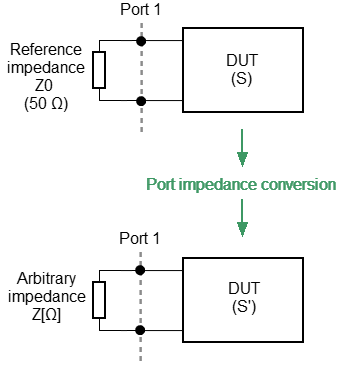The default reference impedance of a port is equal to the reference impedance of the connectors (50 or 75 Ω). But in the process, it is often required to measure DUT with arbitrary resistance (See example in the figure below), not equal to the reference impedance of a port. In this case, it is possible to convert the reference impedance to an arbitrary impedance value using the software.
The functions are applicable for reflection coefficients (S11, S22 etc.) measurement only.

Example of measuring a DUT with an arbitrary impedance by the Analyzer with reference impedance 50 Ω
note |
The value of the test port impedance is defined in the process of calibration. It is determined by the characteristic impedance of the calibration kit. |
Port reference impedance conversion is a function that mathematically converts the matrix of S-parameters measured at the reference impedance of port Z0 to the matrix of S-parameters measured at an arbitrary impedance of port Z (See figure below). The function is also referred to as the renormalization transformation of S-parameters.

Port reference impedance conversion
Renormalization is based on "A General Waveguide Circuit Theory" (R.B.Marks and D.F.Williams).
To open the fixture simulation menu, use the softkeys Analysis > Fixture Simulator on left menu bar. To enable/disable the port impedance conversion function, click on the Port Z Conversion field. To enter the value of the simulated impedance of Port, click on the Port Z0 field and enter the value using the on-screen keypad.
|
note |
The source value of the Z0 port reference impedance (commonly 50 Ω) is defined in the process of the calibration. It is determined by the characteristic impedance of the calibration kit and its value is entered as described in System Impedance Z0. |


